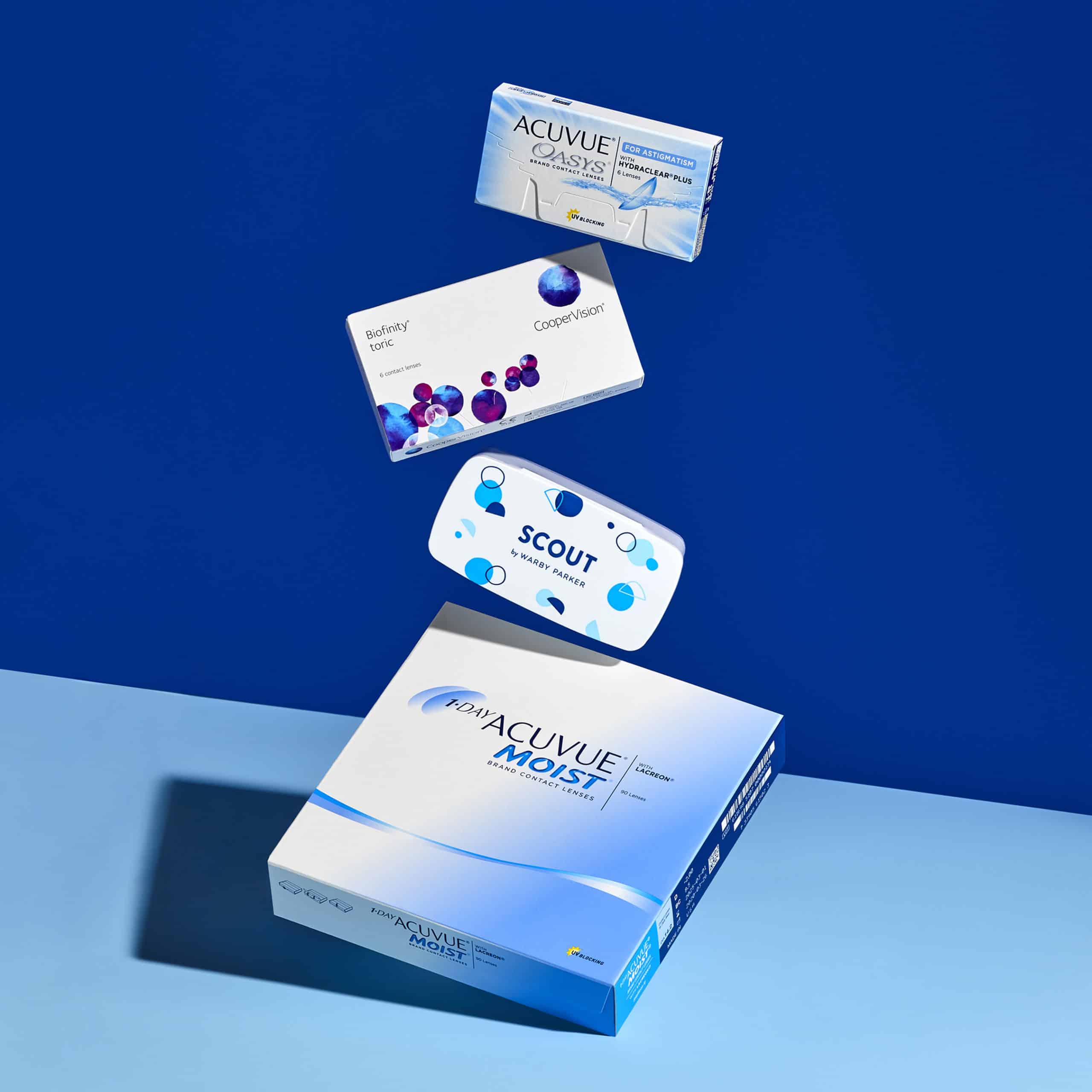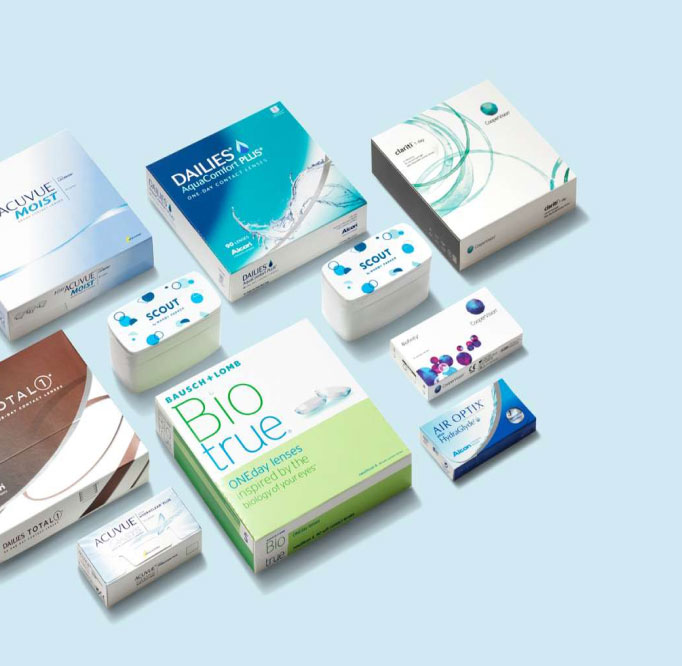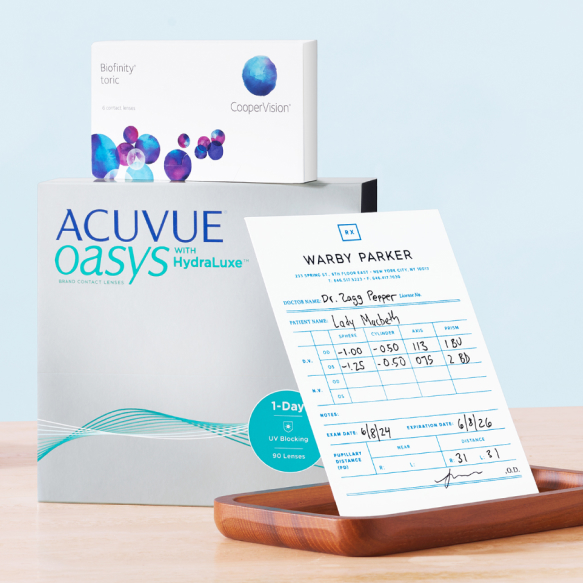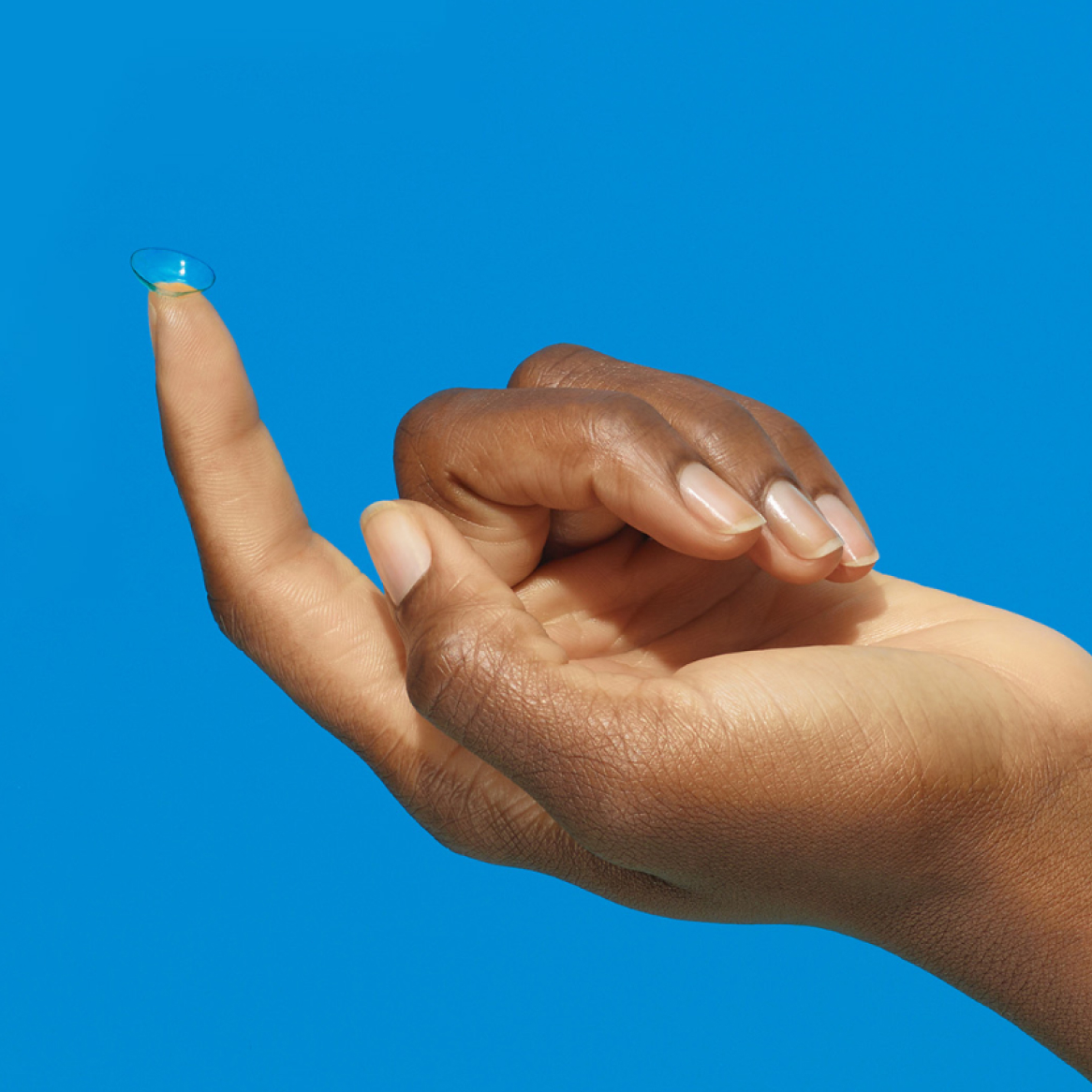Contact lenses have come a long way from their 19th-century roots. The earliest versions were fashioned from blown glass, didn’t let much oxygen through, and understandably couldn’t be worn for very long. Today, it’s a different story: You can find a range of comfortable, breathable contact lenses—and even order them online. Cheers for progress!
But even if you wear contacts regularly, you may not know how they work and which types are available to help with different eye conditions. That’s why we have this guide with all the contact lens info you need to know.
Contact lenses are thin, plastic lenses that correct vision problems when worn directly on the cornea—the front surface of the eye. This aspect differentiates them from glasses, which are worn at a slight distance away from the eyes.
Contacts are typically shaped like small, transparent bowls. When they’re placed in your eyes correctly, they make your vision clearer while remaining largely unnoticeable to other people.
When they’re worn to correct vision, contact lenses work by bending light as it enters the eye. The light then hits the eye’s retina in just the right spot to produce sharp, accurate images.
Glasses work the same way—both types of lenses are addressing refractive errors in the eye that keep light from focusing properly.
Contacts stay in your eye by sticking to the tear film, which is the layer of fluid on your eye that keeps it moist and protected. Due to this gentle but close adhesion, they move naturally with your eye and won’t become dislodged when you blink.
The type of contact lens your eye doctor prescribes will depend on your visual and medical needs.
Soft contact lenses are thin and flexible, so they mold easily to the shape of your eye. After years of innovation, soft contacts first became available in America in the 1970s and have since come to occupy the top spot in the contact world: about 86% of Americans who wear contacts use soft lenses.
Soft contacts are great at retaining moisture and letting oxygen through to the eye. They’re generally considered the most comfortable type of contact lens.
Rigid gas permeable contacts are “hard” contact lenses—they can’t bend and flex like soft ones. However, as their name suggests, they still let oxygen through their structure so your eyes can breathe.
RGP lenses are less prone to collecting irritating deposits than soft lenses, and they can also offer crisper vision correction. The downside? They take some time to get used to, and many people find them less comfortable than soft lenses at first.
Schleral contact lenses are rigid gas permeable contacts that extend over a broader portion of the eye to cover the sclera, which is the white part of your eye. They’re usually prescribed to help vision issues caused by corneal abnormalities.
Hybrid contacts combine the benefits of soft lenses and RGPs by having a rigid zone in the center and a soft “skirt” of material surrounding it. This construction provides the clearer vision of an RGP lens with the comfort of a soft one.
Hybrid lenses require a very precise fit and tend to cost more than other types of contacts, so they aren’t as widely used.
Most contact lenses sold today are made of different types of polymers. Soft lenses are made of hydrogels, which are plastics that incorporate water into their design for added hydration.
In recent years, more soft contact lenses have been made from silicone hydrogels. Silicone hydrogel lenses allow even more oxygen through to the eye than “regular” hydrogels, and they dehydrate less when worn for longer durations. They’re thought to be the most advanced soft lenses available.
As for RGP lenses, they’re also made of plastic—it’s just a more rigid kind.
The different types of contact lenses can address various eye conditions, both mild and severe. Some are even worn purely for cosmetic purposes.
But remember: No matter the reason you’re wearing contacts, you should always have a prescription for them.
Single-vision contacts correct refractive errors such as nearsightedness, farsightedness, and astigmatism. They have a single “power” of vision correction built into the lens—meaning they make your vision clearer in one specific way. This power appears in the sphere (SPH) column of your contact lens prescription as a positive or negative number of diopters, indicating the strength of your prescription.
Toric contact lenses help compensate for the unevenly curved corneas of eyes with astigmatism. These lenses can also simultaneously correct for other refractive errors like nearsightedness and farsightedness. They’re called toric lenses because they’re shaped like a slice from a torus (a donut shape) rather than from a sphere.
Unlike most other contact lenses, toric lenses have a “correct” orientation on the surface of the eye, and they shouldn’t rotate in other directions. They also have a cylindrical power component, measured in diopters, in addition to a spherical power component.
So, if you wear toric contacts, you’ll see numbers in the “SPH,” “CYL,” and “Axis” columns on your prescription. Toric lenses need this additional measurement because a cornea with astigmatism is not completely spherical—its uneven curve merits a slightly more complex prescription.
Multifocal contacts can correct vision at various distances using multiple zones within the same lens. These zones have different powers of vision correction—and as a result, they can take some getting used to. Looking through one area of the lens might help you with near vision, while looking through another helps with distance vision.
Eye care professionals often recommend multifocal and bifocal contacts to people who wear progressive glasses for presbyopia or have markedly different prescriptions for far and near vision.
Although many contact lenses are transparent and hard to notice, some are designed to enhance the eye with colors. These colored contacts can be subtle or bold, and they might correct your vision or just be for show. (Of course, they still require a prescription either way!)
For even more niche visual needs, you might need to try one of these types of contacts:
- Monovision contacts: A set of two contacts worn to correct distance vision and presbyopia, monovision contacts provide you with two lenses: one that corrects your near vision in one eye, and one that corrects distance vision in the other. Your brain eventually adjusts to the lenses so you look out of whichever one you need for a given task.
- Orthokeratology (Ortho-K): This is a treatment that involves wearing rigid gas permeable contacts overnight while you sleep. Over time, the contacts gradually reshape your cornea to offset the effects of myopia. These benefits will go away once you stop wearing the lenses regularly.
How Much Do Contact Lenses Cost?
By and large, the cost of contact lenses will depend on your vision needs and prescription. In general, single-vision monthly contacts are the least expensive. Daily disposable and specialty contacts usually cost more. Colored contacts and lenses that correct more than one refractive error tend to add dollars, too.
Whether contacts are considered “expensive” will vary from one person to another. Many people find it worth the cost to buy contacts that properly correct their vision and work best for their lifestyle.
To get a contact lens prescription, you’ll need an eye exam. A contact lens prescription is separate from a glasses prescription, and your eye doctor will need to perform a contact lens exam and fitting to see what type of contact will suit your eyes best.
When you book the exam, be sure to let the appointment scheduler know you’re interested in wearing contact lenses.
Different contact lenses have different wear durations and replacement schedules. It’s crucial to know how long you can safely leave your contacts in your eyes, when to store them, and when to dispose of them.
In any case, though, you’ll have to replace your contact lenses at some point—none of them are made to last forever.
Disposable contacts are contact lenses you wear and then throw out according to their replacement schedule. Soft disposable contacts are available in daily, biweekly, and monthly varieties, and the cost of contact lenses varies with the type of lenses you purchase.
Disposable contacts are meant to be worn during the day and either stored or tossed out at night. They’re typically safe to stay in your eyes for around 8 to 16 hours at a time, depending on the manufacturer’s instructions.
Many people like the convenience of daily contacts because they don’t have to be cleaned or stored—you simply dispose of them once you take them out. But biweekly and monthly contacts have their devoted fans, too. They’re a bit more affordable than daily lenses and you don’t have to buy as many at a time.
However, you do have to clean them regularly and store them in solution-filled cases each night. You’ll replace them with fresh lenses once their designated longevity—up to two weeks or a month—has passed.
(Read our guide to daily vs. monthly contacts for more information on the differences between those two types.)
Extended Wear Contacts
Extended wear contacts have been approved by the FDA for longer wear times than other disposable contacts. Advertising for extended wear contacts may say that you can leave them in your eyes for up to seven days at a time, including overnight.
However, sleeping in your contact lenses is almost never recommended, because it poses the risk of eye infection and other complications. You should always check with your eye doctor before leaving extended wear contacts in your eyes for longer than a day.
RGP contacts aren’t labeled as disposable, and they can be reused for multiple months if cared for properly.
Contact Lens Brands
When you get your prescription, it should include the contact lens brand since each brand has its own fit. Your eye doctor specifies the contacts that best fit your eyes and address your vision needs.
Numerous brands, such as ACUVUE®, AIR OPTIX®, Biofinity®, and ULTRA® offer FDA-approved contact lenses. If you’re interested in trying a particular brand (or type) of contacts, discuss it with your eye doctor.
To prevent eye injury or even permanent eye damage, be sure to have a prescription and purchase your contacts from a reputable retailer.
Perhaps the most daunting part of wearing contact lenses is the act of putting them in. Or maybe it’s taking them out? Or maybe it’s both.
Regardless, we’ve got your back: Here are step-by-step guides for each part of the process.
It’s important to note that first-time contact lens wearers should go through an in-person training an eye doctor to learn how to put in and take out contacts.
All types of contact lenses require some amount of care and maintenance—yes, even the daily disposables. Here are some general tips to follow if you want to be an ace contact caretaker with healthy eyes:
- Wash your hands before and after touching your lenses and your eyes. You don’t want to transfer any germs or grime while you’re handling your contacts.
- Be gentle with your contacts. They’re medical devices, but they’re also delicate. They can rip or tear if subjected to enough force. Treat your contacts tenderly and consider keeping your nails short as you get used to wearing them.
- When in doubt or discomfort, clean your lens. Don’t leave an uncomfortable lens in your eye. Retrieve it, clean it, inspect it, and replace it if anything still looks or feels off.
- Keep some multipurpose contact solution and a storage case on hand. You never know when you’ll need to remove and clean a lens. It’s probably a good idea to keep a pair of backup glasses on you, too.
- Water and contacts don’t mix. Don’t go swimming in contacts, and please don’t shower with them in, either. Getting them wet ups your chances of irritation and infection (not to mention you might lose them to the drain!).
- Don’t sleep in your contacts. Sorry, we know it’s tempting, but it can dry out your eyes and (yes, this again) increase your risk of infection.
Contacts are tiny yet marvelous pieces of technology that help us see the world. Luckily for us, they’re becoming more advanced each year—and we might soon have contacts that steadily release medicine to help dry eye, glaucoma, and other conditions. Who knows what other types of contacts we might see in the future? Our hope is that you feel more informed about the ones you might choose to wear today.
If you’re new to wearing contacts, schedule an appointment for an eye exam. You’ll need a contacts prescription before you start shopping for lenses that fit your needs.





